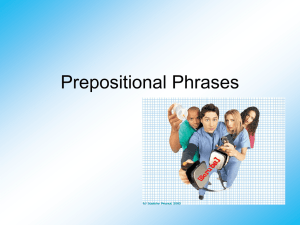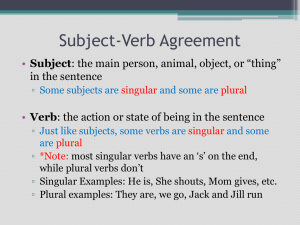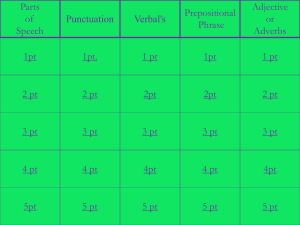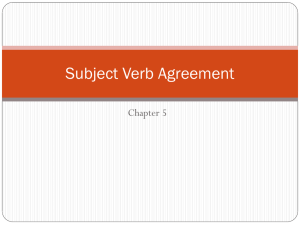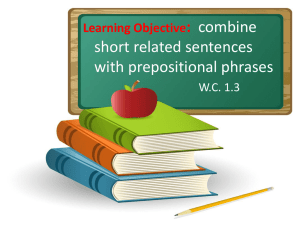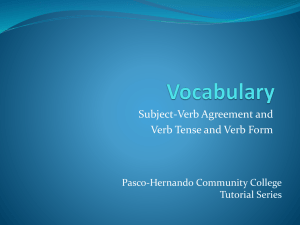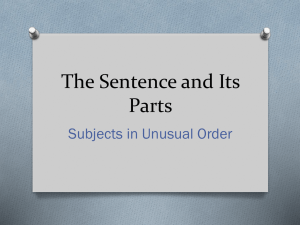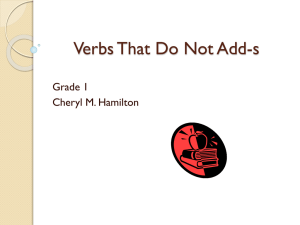Subject-Verb Agreement with Prepositional Phrases
advertisement
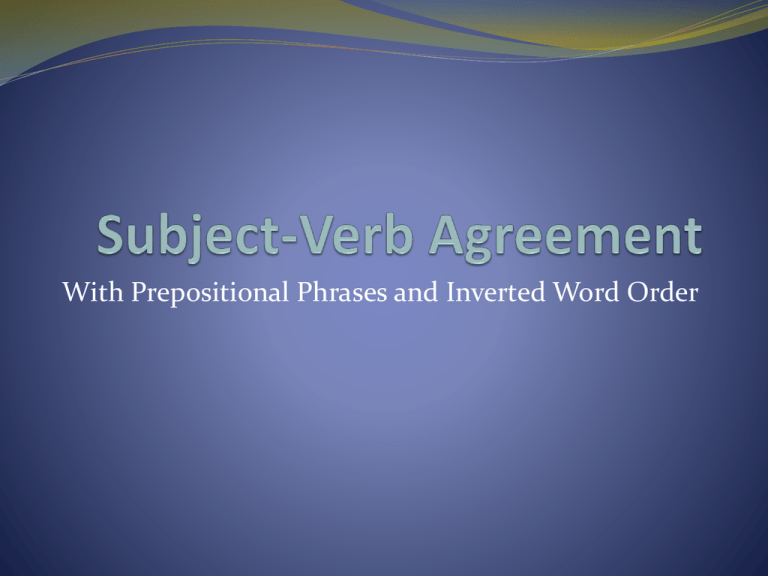
With Prepositional Phrases and Inverted Word Order What is Subject-Verb Agreement? As we have said before, every sentence has: A SUBJECT that tells who or what the sentence is about A VERB that tells what the subject does In every sentence, the subject and verb have to “agree.” What does this mean? If you have a singular noun, you must use a singular verb. If you have a plural noun, you must use a plural verb. What is wrong with these sentences? The balloon are colorful. The peaches is ripe. The horses gallops. Tabitha ride the train. He repair the bicycle. What is Subject-Verb Agreement? Like we said, singular nouns must have singular verbs and plural nouns must have plural verbs: Balloon is (singular – singular) Peaches are (plural – plural) Horses gallop (plural – plural) Tabitha rides (singular – singular) He repairs (singular – singular) General Rules of S-V Agreement Singular noun = one Plural noun = more than one For most singular verbs, add an S For most plural verbs, don’t add an S Of course, there are verbs with different singular/plural forms such as: is/are has/have Problems In most cases, you can probably easily choose which verb agrees with the subject of a sentence. But, sometimes there are tricky sentences that can confuse you and make it hard to find the subject of the sentence. Prepositional Phrases Indefinite Pronouns Inverted Word Order Compound Subjects Collective Nouns Why does this matter? Because if you don’t know what the subject of the sentence is, you can’t make the verb agree with it. Review: Prepositional Phrases Before we move on, let’s stop and review what a prepositional phrase is. Prepositions: show relationship between words in a sentence. Remember “the mountain”? I walked _____________ the mountain ^^Words that fit in the blank are probably prepositions BUT not all prepositions fit in the blank. Prepositions Prepositional Phrases A prepositional phrases begins with a preposition word (like the ones we just looked at in the list) and a noun/pronoun (+ any adjectives describing it). I went to the store. Jake from State Farm is on the phone. The president of the club is speaking to the members. Subject-Verb Agreement with Prepositional Phrases So, what do prepositional phrases have to do with subject-verb agreement? Sometimes, prepositional phrases come between the subject and verb of a sentence. The president of the club is speaking to the members. When prepositional phrases come between the subject and verb, it can lead you to choosing the incorrect verb form. Subject-Verb Agreement with Prepositional Phrases The verb in the sentence needs to “agree” with the subject of the sentence, not the noun/pronoun in the prepositional phrase. The players on the baseball team were disappointed. The subject will NEVER be located within the prepositional phrase. Subject-Verb Agreement with Prepositional Phrases So, how do you avoid mistakes in subject-verb agreement when a prepositional phrase comes between them? 1. Identify the prepositional phrase of the sentence. Put parentheses around it. 2. Identify the subject of the sentence – remember: it will NOT be located within the prep phrase. Circle it. 3. Now, ignore the prepositional phrase and look at only the subject and verb of the sentence. Decide which form of the verb will agree with the subject. Practice 1. A bag of marbles (is / are) on the shelf. 2. The peppers in the garden (has / have) grown quickly. 3. The moon over the ocean (is / are) a beautiful sight. 4. The hands on my watch (glows / glow) in the dark. 5. Four students from our school (plays / play) in the band. S-V-A with Inverted Word Order So far, we have often seen that the subject comes at the beginning of the sentence. However, sometimes there are other words at the beginning of the sentence that are not actually the subject of the sentence. This can happen when: A prepositional phrase is at the beginning of the sentence (instead of between the subject + verb) Sentences start with here or there Sentences that ask a question Prep. Phrases @ Beginning of Sentence Sometimes, prepositional phrases will come at the beginning of the sentence. Like we said we when talked about prepositional phrases that come in between the subject and the verb: the prepositional phrase will never contain the subject of the sentence. To find the subject in these types of sentences: 1. Find a preposition word 2. Put parentheses around the entire prep phrase 3. Look at the remaining words in the sentence and decide who or what the sentence is about. Practice 1. Across the ocean (sails / sail) millions of boats. 2. From the roof of the porch (hangs / hang) several flower baskets. 3. Among the shrubs (was / were) a tiny kitten. Here and There Some sentences begin with the words here and there. The words here and there are never the subject of the sentence. In sentences like these, the verb will usually come before the subject (instead of the usual subject-verb order). Ex: Here is a picture of my grandparents. To decide if the subject and verb agree, you can rearrange the sentence to see if it sounds correct. Ex: A picture of my grandparents is here. Practice 1. Here (is / are) the garden chairs for your party. 2. There (is / are) your lost shoes. 3. There (is / are) my classmate! Question (Interrogative) Sentences In some interrogative sentences, a helping verb comes before the subject and is separated from the main verb. To find the subject of these sentences, look between the helping verb and the main verb. Ex: Do these stories interest you? To see if the subject and verb agree correctly, you can rearrange the sentence into a statement. Ex: These stories do interest you. Practice 1. (Has / Have) rabbits destroyed your garden this summer? 2. (Is / Are) the eighth-graders having a school dance? 3. (Does / Do) marigolds bloom in the spring?
